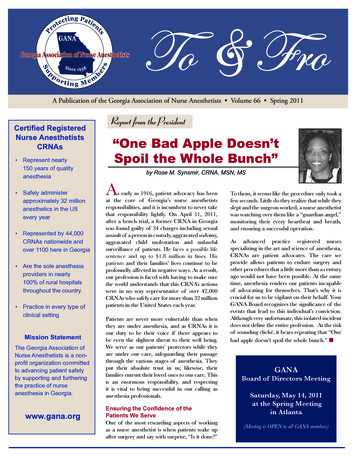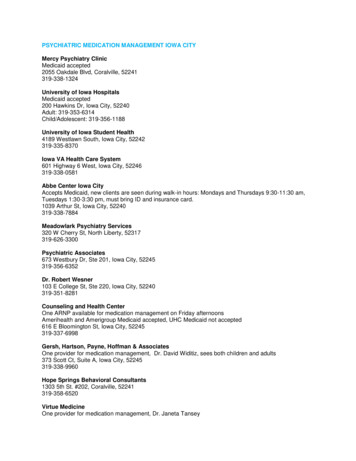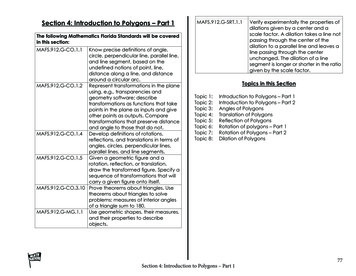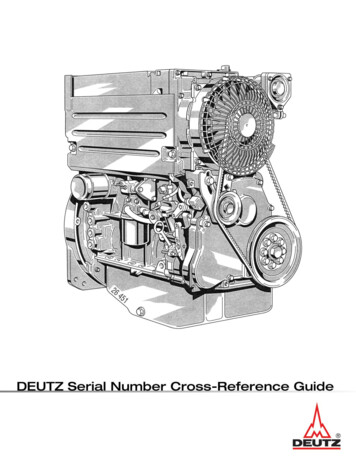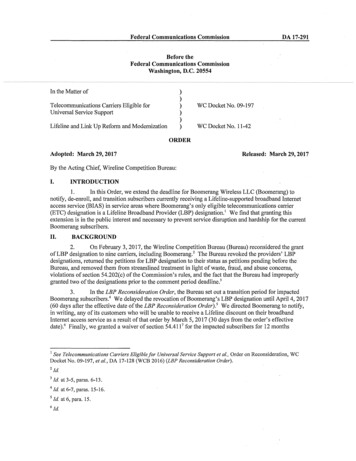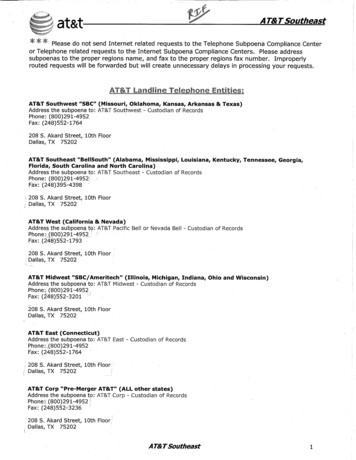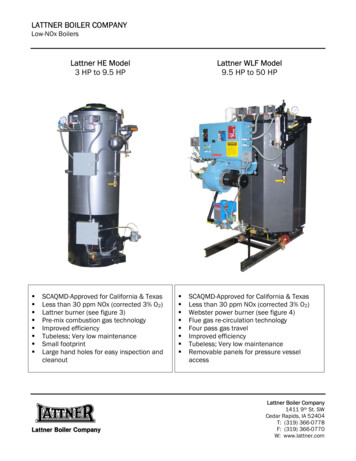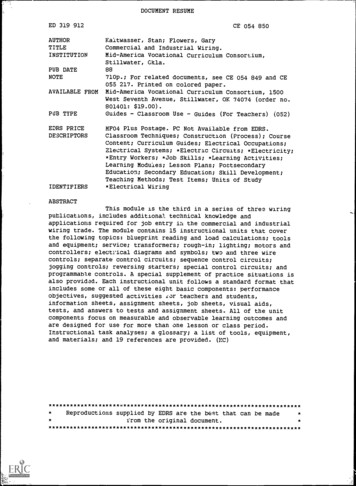
Transcription
DOCUMENT RESUMEED 319 912CE 054 850AUTHORTITLEINSTITUTIONKaltwasser, Stan; Flowers, GaryCommercial and Industrial Wiring.Mid-America Vocational Curriculum Consortium,Stillwater, Okla.PUB DATENOTE88AVAILABLE FROMPUB TYPEEDRS PRICEDESCRIPTORSIDENTIFIERS710p.; For related documents, see CE 054 849 and CE055 217. Printed on colored paper.Mid-America Vocational Curriculum Consortium, 1500West Seventh Avenue, Stillwater, OK 74074 (order no.801401: 19.00).Guides - Classroom UseGuides (For Teachers) (052)MF04 Plus Postage. PC Not Available from EDRS.Classroom Techniques; Construction (Process); CourseContent; Curriculum Guides; Electrical Occupations;Electrical Systems; *Electric Circuits; *Electricity;*Entry Workers; *Job Skills; *Learning Activities;Learning Modules; Lesson Plans; PostsecondaryEducation; Secondary Education; Skill Development;Teaching Methods; Test Items; Units of Study*Electrical WiringABSTRACTThis module is the third in a series of three wiringpublications, includes additional technical knowledge andapplications required for job entry in the commercial and industrialwiring trade. The module contains 15 instructional units that coverthe following topics: blueprint reading and load calculations; toolsand equipment; service; transformers; rough-in; lighting; motors andcontrollers; electrical diagrams and symbols; two and three wirecontrols; separate control circuits; sequence control circuits;jogging controls; reversing starters; special control circuits; andprogrammable controls. A special supplement of practice situations isalso provided. Each instructional unit follows a standard format thatincludes some or all of these eight basic components: performanceobjectives, suggested activities or teachers and students,information sheets, assignment sheets, job sheets, visual aids,tests, and answers to tests and assignment sheets. All of the unitcomponents focus on measurable and observable learning outcomes andare designed for use for more than one lesson or class period.Instructional task analyses; a glossary; a list of tools, equipment,and materials; and 19 references are provided. **************************Reproductions supplied by EDRS are the best that can be made*from the original *********************************
12111U S OEPARTMENT OF EDUCATIONand Improvement()Ike 91 Educabonat ResearchRESOURCES INFORMATIONEDU ATIONALRESOURCESbeen reproduced asonreceived from the person or organizatiO his document hasoriginating it.been made to improveO Minor changes navereproduction qualityStated in this docirPoints of view or opinions represent officialment do not necessarilyOERI position or policy"PERMISSION TO REPRODUCE THISMATERIAL IN MICROFICHE ONLYHAS BEEN GRANTED BYTO THE EDUCATIONAL RESOURCESINFORMATION CENTER (ERIC)"8014018D-005920BEST COPY AVAILABLE2
3
COMMERCIAL AND INDUSTRIAL WIRINGWritten byStan KaltwasserGary FlowersEdited byJane HustonDeveloped byThe MidAmerica Vocational Curriculum Consortium, Inc.Board of DirectorsHarley Schlichting, Missouri, ChairmanRon Mehrer, North Dakota, Vice ChairmanJoyce Sawatzky, Oklahoma, ParliamentarianJim Adams, ArkansasDorothy Horrell, ColoradoVernon Fennell, IowaLes Abel, KansasDavid Poston, LouisianaAnn Masters, NebraskaLarry Zikmund, South DakotaRobert Patterson, TexasGreg Pierce, Executive Director80140189-0059204
0 1988 by the Mid-America Vocational Curriculum Consortium, Inc.All rights reserved. No part of this bookmay be reproduced in any form or by anymeans without written permission from the publisher.Printed in the United States of America by theOklahoma State Department of Vocational-Technical EducationStillwater, OK 74074Mid-America Vocational Curriculum Consortium, Inc.1500 West SeventhStillwater, Oklahoma 74074-43645
COMMERCIAL AND INDUSTRIAL WIRINGTABLE OF CONTENTSUnit I:Blueprint Reading and Load CalculationsUnit Ii:Tools and EquipmentUnit Iii:Service139Unit IV:Transformers171Unit V:Rough-In225Unit VI:Lighting281Unit VII:Motors and Controllers319Unit VIII:Electrical Diagrams and Symbols411Unit IX:Two and Three Wire Controls437Unit X:Separate Control Circuits501Unit XI:Sequence Control Circuits537Unit XII:Jogging Controls563Unit XIII:Reversing Starters599Unit XIV:Special Control Circuits645Unit XV:Programmable Controls697Scenarios (Special Supplement)743171iii6
FOREWORDCommercial and Industrial Wiring is the third in a series of three wiring publications andincludes the additional technical knowledge and applications required for job entry in thecommercial and industrial wiring trade.Basic Wiring, the first publication in the series, serves as the foundation for students enrolledin a wiring program. It is a prerequisite to either Commercial and Industrial Wiring or Residential Wiring. This series should provide the flcbility that instructors need to meet the individual needs of their students and the community.Residential Wiring, the second publication in the series, is a revision of MAVCC's 1983 wiringpublication of the same name. This manual picks up where Basic Wiring ends and preparesthe student for entry-level employment in the residential wiring trade.These publications were developed with the assistance of many individuals who have expertise in various areas of the wiring trade. Some of these individuals represent professionalassociations and industry. Their assistance and devotion to this project is greatly appreciated.It should be emphasized that the student needs to be aware of professioral trade associations and take an active part in them as much as possible. The professional trade associations, as well as vocational education, are an excellent avenue for continuing education withinthe electrical trade.Every effort has been made to make these publications basic, readable, and by all means, usa-ble. Three vital parts of instruction have been intentionally omitted from these publications:motivation, personalization, and localization. Those areas are left to the individual instructorsand the instructors should capitalize on them. As these publications are used, it is hoped thatstudents performance will improve and that students will be better able to assume a role inelectrical wiring.Harley Schlichting, ChairmanBoard of DirectorsMid-America VocationalCurriculum ConsortiumGreg PierceExecutive DirectorMid-America VocationalCurriculum Consortiumv7
ACKNOWLEDGEMENTSAppreciation is extended to those individuals who contributed their time and talent to thedevelopment of Commercial and Industrial Wiring.The contents of this publication were planned and reviewed by:Loren AmerineBill BarnesHarold BrownDaniel FrohbergTracy NaasMike PedersenClifford SchaeferRandy WilsonHoisington, KansasLittleton, ColoradoHope, ArkansasNorfolk, NebraskaKloten, North DakotaSheldon, IowaFt. Worth, TexasStillwater, OklahomaA special thank you goes to the following for granting MAVCC permission to reprint certaingraphic materials that enhance this text: Jim Johnson, Telemecanique, Inc.; Mike Wan less andDan Rood, Hunzicker Brothers; Tel-A-Train Inc.; Advance Transformer Company; Square DCompany and Cutler-Hammer.Appreciation is also extended to the technical artist, Donna Bellmon, and to members of theOklahoma State Vo-Tech Print Shop for their excellent service in printing the text.The text was phototypeset in the Oklahoma State Vo-Tech Communications Center, and fortheir excellent contribution, a thank you goes to phototypesetters Stephanie Smola and EvaRobbins.Thanks are also extended to Jane Huston, coordinator and editor of this project.vii8
USE OF THIS PUBLICATIONInstructional UnitsCommercial and Industrial Wiring contains fifteen units of instruction. Each instructionalunit includes some or all of the basic components of a unit of instruction; performance objectives, suggested activities for teachers and students, information sheets, assignment sheets,job sheets, visual aids, tests, and answers to the tests. Units are planned for more than onelesson or class period of instruction.Careful study of each instructional unit by the teacher will help to determine:A.B.The amount of material that can be covered in each class periodThe skills which must be demonstrated1.2.3.4.C.D.Supplies neededEquipment neededAmount of practice neededAmount of class time needed for demonstrationsSupplementary materials such as pamphlets or filmstrips that must be orderedResource people who must be contactedObjectivesEach unit of instruction is based on performance objectives. These objectives state thegoals of the course, thus providing a sense of direction and accomplishment for the student.Performance objectives are stated in two forms: unit objectives, stating the subject matterto be covered in a unit of instruction; and specific objectives, stating the student performancenecessary to reach the unit objective.Since the objectives of the unit provide direction for the teaching-learning process, it isimportant for the teacher and students to have a common understanding of the intent of theobjectives. A limited number of performance terms have been used in the objectives for thiscurriculum to assist in promoting the effectiveness of the communication among all individuals using the materials.Reading of the objectives by the student should be followed by a class discussion toanswer any questions concerning performance requirements for each instructional unit.Teachers should feel free to add objectives which will fit the material to the needs of the students and community. When teachers add objectives, they should remember to supply theneeded information, assignment and/cr job sheets, avid criterion tests.ix9
Suggested Activities for the instructorEach unit of instruction has a suggested activities sheet outlining steps to follow in accomplishing specific objectives. Duties of instructors will vary according to the particular unit;however, for best use of the material they should include the following: provide students withobjective sheet, information sheet, assignment sheets, and job sheets; preview filmstrips,make transparencies, and arrange for resource materials and people; discuss unit and specific objectives and information sheet; give test. Teachers are encouraged to use any additional instructional activities and teaching methods to aid students in accomplishing theobjectives.Information SheetsInformation sheets provide content essential for meeting the cognitive (knowledge) objectives in the unit. The teacher will find that the information sheets serve as an excellent guidefor presenting the background knowledge necessary to develop the skill specified in the unitobjective.Students should read the information sheets before the information is discussed in class.Students may take additional notes on the information sheets.Transparency MastersTransparency masters provide information in a special way. The students may see as wellas hear the material beinr; presented, thus reinforcing the learning process. Transparenciesmay present new information or they may reinforce information presented in the informationsheets. They are particularly effective when identification is necessary.Transparencies should be made and placed in the notebook where they will t a immediatelyavailable for use. Transparencies direct the class's attention to the topic of discussion. Theyshould be left on the screen only when topics shown are under discussion.Assignment SheetsAssignment sheets give direction to study and furnish practice for paper and pencil activities to develop the knowledge which is a necessary prerequisite to skill development. Thesemay be given to the student for completion in class or used for homework assignments.Answer sheets are provided which may be used by the student and/or teacher for checkingstudent progress.Job SheetsJob sheets are an important segment of each unit. The instructor should be able to demonstrate the skills outlined in the job sheets. Procec;ures outlined in the job sheets give directionto the skill being taught and allow both student and teacher to check student progress towardthe accomplishment of the skill. Job sheets provide a ready outline for students to follow ifthey have missed a demonstration. Job sheets also furnish potential employers with a pictureof the skills being taught and the performances which might reasonably be expected from aperson who has had this training.10x
eTest and EvaluationPaperpencil and performance tests have been constructed to measure student achievement of each objective listed in the unit of instruction. Individual test items may be pulled outand used as a short test to determine student achievement of a particular objective. This kindof testing may be used as a daily quiz and will help the teacher spot difficulties being encountered by students in their efforts to accomplish the unit objective. Test items for objectivesadded by the teacher should be constructed and added to the test.Test AnswersTest answers are provided for each unit. These may be used by the teacher and/or studentfor checking student achievement of the objectives.
eCOMMERCIAL AND INDUSTRIAL WIRINGINSTRUCTIONAL TASK ANALYSISJOB TRAINING: What theWorker Should Be Able to Do(Psychomotor)RELATED INFORMATION: Whatthe Worker Should Know(Cognitive)UNIT I: BLUEPRINT READING AND LOAD CALCULATIONS1.Terms and definitions2.M6chanical symbols3.Plumbing symbols4.Structural symbols5.Architectural symbols6.Electrical symbols7.Panel, circuit, and other electrical symbols8.Types of blueprint lines9.Typical electrical specifications10.Minimum requirements for electricaldevices16.Construct an electrical blueprint17.Perform load calculations18.Compute lighting loads19.Derate neutral loads20.Determine maximum numbers of conductors in conduit21.Compute voltage drop11.Determining motor-circuit wire sizes12.Load calculations13.Demand factor14.Voltage drop15.Types of blueprintsii2
JOB TRAINING: What theWorker Should Be Able to Do(Psychomotor)RELATED INFORMATION: Whatthe Worker Should Know(Cognitive)UNIT II: TOOLS AND EQUIPMENT9.Bend, cut, ream and thread 112-inchrigid metal conduit10.Bend EMT stub-ups11.Make back-to-back bends on 112-inchEMT12.Make offset bends on 1/2-inch EMT13.Bend and install 1/2-inch EMT14.Bend a three-point saddle on 1/2-inchEMT15.Bend a four-point saddle on 112-inchEMT16.Cut, ream, offset, and install connectors on 1/2-inch PVC13xiv1.Terms and definitions2.Types of conduit benders3.Wire termination tools4.Wire and cable pulling equipment5.Conduit cutting and threading tools6.Knockout cutters7.Power actuated tools8.Types of excavation equipment
CRELATED INFORMATION: Whatthe Worker Should Know(Cognitive)JOB TRAINING: What theWorker Should Be Able to Do(Psychomotor)UNIT III: SERVICE10.1.Terms and definitions2.NEC requirements for drop clearanceand lateral::3.Switch gears and disconnects4.NEC exceptions for overcurrent protection devices5.Methods of determining sh ort circuitcurrent protection6.Grounding electrodes an ground fault7.Service entrance devic s8.Emergency and stan dby systems9.Procedure for bale ncing loadsInstall an overhead raceway with serv-ice entrance conductors to a meterbase11.Connect meter base assembly to loadcenter or panelUNIT IV: TRANSFORMERS1.Term s and definitions2.Ba sic types of transformers3.Diagrams of the two most commonlyused voltage systems4.NEC requirements for dry type transformers5.NEC requirements for oilfilled transformers14xv
JOB TRAINING: What theWorker Should Be Able to Do(Psychomotor)RELATED INFORMATION: Whatthe Worker Should Know(Cognitive)6.NEC requirements for askarel-filledtransformers7.Function of a buck and boost transformer8.9.Transformer locationsInstallation and termination of transformers10.Locate and list two exceptions ontransformer room construction for drytype transformers11.Locate and list two exceptions concerning oil-insulated transformers12.Draw a three-wire wye-delta transformer13.Convert amperes to KVA on a threephase system14.Test transformer turn ratios15.Test transformer insulation resistance16.Connect three transformers in a deltadelta configuration17.Connect transformer primary and secondary windings in a delta-wye configurationUNIT V: ROUGHINxvi1.Terms and definitions2.Branch circuit and feeder installation3.Devices used in special circuit installationsj5
RELATED INFORMATION: Whatthe Worker Should Know(Cognitive)JOB TRAINING: What theWorker Should Be Able to Do(Psychomotor)4.Steps for determining the number ofconductors allowed in a conduit,based on cross-sectional area5.Exceptions to the NEC requirementsfor support of flexible metal conduit6.Optional calculations for additionalloads to existing installations7.Determine the number of conductorsallowed to be added to an existing conduit8.Rough-in a wood framed wall9.Install outlet boxes on steel rods10.Install outle% boxes on steel studsusing caddy metal stud clips for switch11.Install masonry boxes in a block wallUNIT VI: LIGHTING1.Terms and definitions2.Basic types of lighting3.Characteristics of incandescent lighting4.Characteristics of flourescent lighting5.Characteristics of high intensity discharge lamps6.Methods of calculating light7.Calculating branch circuits and voltage8.Switching systemsxvii16
JOB TRAINING: What theWorker Should Be Able to Do(Psychomotor)9.Locate articles in the NEC concerninglighting requirements10.Change a two lamp ballast in a floures-RELATED INFORMATION: Whatthe Worker Should Know(Cognitive)cent fixture11.Change sockets in a flourescent fixture12.Change an HID ballast13.Change a quartz lampUNIT VII: MOTORS AND CONTROLLERS1.Terms and definitions2.Direct current motor theory of operation3.Typos of DC motors4.Single-phase motor theory of operation5.Types of single-phase motors6.Three-phase motor theory of operation7.Types of three-phase motors8.Reversing a three-phase motor9.Typical supply voltage for three-phasemotors10.Dual voltage schematics and terminalconnections11.Motor problems and their typical symptoms12.Remedies for motor problems17e
JOB TRAINING: What theWorker Should Be Able to Do(Psychomotor)RELATED INFORMATION: Whatthe Worker Should Know(Cognitive)13.Safety rules to observe when workingaround motors14.Types of contactors15.Parts of a manual contactor16.Electrical devices or circuits controlledby contactors17.Types of motor starters18.Types of magnetic motor starters19.Uses of magnetic motor starters20.Comparison of parts in magnetic con-tactors with parts in magnetic motorstarters21.Reasons a contactor cannot be used tocontrol a motor24.Interpret nameplate information25.Describe remedies for common motorproblems26.Use the NEC to answer questions22.Purposes of a coil assembly23.Parts of a coil assemblyabout motor control circuits27.Distinguish between motor startersand contactors28.Answer questions about uses of contactors and motor starters29.Disassemble, inspect, and clean amotor18xix
JOB TRAINING: What theWorker Should Be Able to Do(Psychomotor)RELATED INFORMATION: Whatthe Wcrker Should Know(Cognitive)30.Identify run, common, and start terminals on a hermetically sealed motor31.Test capacitors with an ohmmeter32.Wire a three-phase motor for dual voltages33.Perform maintenance on a magneticmotor starter or contactorUNIT VIII: ELECTRICAL DIAGRAMS AND SYMBOLS1.Terms and definitions2.Characteristics of wiring diagrams3.Characteristics of ladder diagrams4.Characteristics of one-line diagrams5.Wiring and ladder diagram symbols6.Major steps in constructing a ladderdiagram7.Construct a basic ladder diagram8.Identify electrical symbols in a wiringdiagramUNIT IX: TWO AND THREE WIRE CONTROLSxx1.Terms and definitions2.Typical two-wire pilot devices3.Advantages of twowire controls4.Basic rule for threewire controls
JOB TRAINING: What theWorker Should Be Able to Do(Psychomotor)RELATED INFORMATION: Whatthe Worker Should Know(Cognitive)5.Advantages of three-wire controls6.Operation of a two-wire control system7.Operation of a three-wire control system8.Complete a ladder and a wiring diagram of a two-wire control using a thermal switch9.Draw a ladder diagram of a three-wirecontrol with an "on" indicating pilotfight10.Draw a ladder and a wiring diagram ofa three-wire control with an "off" indicating pilot light11.Determine the number and size of con-ductors needed to operate a two-wirecontrol system12.Determine the number and size of conductors needed to operate a three-wirecontrol system13.Wire a two-wire control14.Wire two float switches to operate astarter (series connection)15.Wire two float switches to operate astarter (parallel connections)16.Wire a pressure switch to operate astarter with "on" and "off" pilot lights17.Wire a three-wire control system18.Wire a multiple station three-wire control19.Wire a multiple station three-wire control with "on" and "off" pilot lights
JOB TRAINING: What theWorker Should Be Able to Do(Psychomotor)RELATED INFORMATION: Whatthe Worker Should Know(Cognitive)UNIT X: SEPARATE CONTROL CIRCUITS1.Terms and definitions2.Reasons for separate control circuits3.Applications for separate control circuits4.Sources of separate control circuits5.Typical control transformer schematics and their voltage ratings6.Necessary changes that must be madeto a starter when using a separate con-trol circuit7.Read and interoret ladder diagramsusing separate control circuits8.9.Answer questions dealing with controlcircuitsDetermine the size and number of con-ductors needed to opmte a separatecontrol circuit10.Wire a relay and a load with a separatecontrol circuit11.Wire a three-phase starter to operateby a separate control circuitUNIT XI: SEQUENCE CONTROL1.Terms and definitions2.Purpose of sequence control3.Advantages of sequence control4.Uses of sequence control2I
0JOB TRAINING: What theWorker Should Be Able to Do(Psychomotor)RELATED INFORMATION: Whatthe Worker Should Know(Cognitive)5.Purpose of auxiliary contact interlccking8.Answer questions related to6.Advantages of auxiliary contact interlocking7.Uses of auxiliary contact interlockingasequence control diagram9.Answer questions related to an auxiliary contact interlocking diagram10.Wire two starters in sequence11.Wire two starters with auxiliary contact interlockingUNIT XII: JOGGING CONTROLS5.Convert three ladder diagrams to wiring diagrams6.Determine the number of conductorsneeded to operate jogging controls7.Wire a jog through a lock-stop push1.Jogging2.Methods of jogging control3.Advantages of jogging control4.Sequence of operation of three ladderdiagramsbutton8.Wire a jog through a twopositionselector switch9.10.Wire a jog through a two-circuit pushbuttonWire a jog through a control relayxxiii4. 4,
JOB TRAINING: What theWorker Should Be Able to Do(Psychomotor)RELATED INFORMATION: Whatthe Worker Should Know(Cognitive)UNIT XIII: REVERSING STARTERS1.Terms and definitions2.Types of reversing starter construction3.Types of interlocking methods forreversing starters6.Describe the sequence of operation ofladder diagrams7.Determine the number of conductorsneeded to operate a reversing control8.Wire a reversing starter with a threeposition selector switch9.Wire a reversing starter with one control station using auxiliary contact andmechanical interlock10.Wire a reversing starter with one control station using push button interlockand auxiliary contact interlock11.Wire a reversing starter with two control stations12.Wire a drum switch13.Wire a reversing starter with jog in bothdirections4.Types of drum controls5.Drum switch diagramxxiv2 3
JOB TRAINING: What theWorker Should Be Able to Do(Psychomotor)RELATED INFORMATION: Whatthe Worker Should Know(Cognitive)UNIT XIV: SrECIAL CONTROL CIRCUi CS10.Build a relay control circuit11.Wire a latching relay or contactor12.Wire a timed on circuit13.Wire a timed off circuit14.Energize three starters in a timed1.Terms and definitions2.Parts of a control relay3.Uses for control relays4.Parts of a latching relay5.Uses for latching relays6.Types of timing relays7.Applications for timing relays8.How a ground fault indicator works9.How an alarm silencing circuit is usedsequential order15.De-energize three starters in a timedsequential order16.E.d a ground fault indicator circuitxxv24
JOB TRAINING: What theWorker Should Be Able to Do(Psychomotor)RELATED INFORMATION: Whatthe Worker Should Know(Cognitive)UNIT XV: PROGRAMMABLE CONTROLS1.Terms and definitions2.Programmable controller functions3.Three stages necessary to control aprocess4.Input devices5.Output devices6.Components of a programmable controller7.States of contacts8.Types of I/O modules9.Parts of an optical coupler10.Basic PC ladder logic symbols11.Why a stop button is wired normallyclosed12.13.Match I/O devices with their functions14.Convert between numbering systemsBasic numbering systems used in programmable controls25
COMMERCIAL AND INDUSTRIAL WIRINGGLOSSARYAAccelerating contactorsContactors or relays used in starting motors at low speed thenincreasing to maximum speed in preset timed stepsAcrossthelineMethod of starting an electric motor by connecting it directly to supply lineAmbient temperatureThe temperature in the area where the transformer is to be !mated.High temperatures will raise the insulation temperatures and shorten the life of the transformer. The KVA rating should be derated .4% for each 1 C over 30 C average ambient temperature for 150 C insulationAmpacity The current in amperes that a conductor can carry continuously under the conditions of use without exceeding its temperature ratingAnalog signalA signal which varies proportionally with some aspect of the environment;the signal from a pressure transducer which varies with the amount of pressure being appliedArc chuteArmaturePartition between contacts to reduce electrical arcingPortion of coil assembl,/ moved by magnetismAutomatic startingPertaining to self-acting starter completely controlled by pilot switchesor some other sensing deviceAuxiliary contactsSet of normally open auxiliary contacts on a starter, contactor, or relaythat close when main contacts close, providing a means of sealing or holding the circuit in theenergized stateBBBlue lampBackhoeMachine used for digging ditches on construction sitesBallastTransformer used in lighting circuitsBenderUsed for bending pipe used in electrical tradesBimetalTwo different metals bonded to p:ovide fast heat transfer to trip contacts bymechanical deflectionBlueprintCopy of the original detailed drawings of a structureBlueprint linesSet of conventional symbols to depict an objectBranch circuitoutletsThe circuit that extends from the cast overcurrent protection device to theBuck and boost transformerA transformer that increases or decreases voltagexxv2 6
C'*.Cable bendersMechanical or hydraulic devices used to bend heavy conductors in panelsand junction boxesCable cuttersUsed in cutting conductorsCathodeCoiled coil or triple coil tungsten wire at each end of lamp which is coated withmaterials which emits electronsCoefficientThe square root of the ratio of the power reflected from a surface to the powerincident of the same surfaceContactorDevice without overload protection; repeatedly establishes and interrupts anelectric power circuitControl transformercontrol voltageSmall transformer used to step supply voltage down to appropriateCopper-clad aluminumAluminum conductor with an outer coating of copper metallurgically bonded to the a: :rninum coreColor codingAssigning colors to conductors based on their usesCounterA logic element in a PC user program which is used to simulate the operation ofelectro-mechanical countersCoveredeConductor encased within material of composition and thickness recognized bythe National Electrical Code as electrical .:.sulationCross phasingcuitUnintentional contact cf two or more electrical phases; results in a short cir-Cross-sectional areaArea in square inches allowed in a conduit or tubing; area required forconductors in a conduit or tubingCTCurrent transformerCutting toolsCWSaws used in cutting conduit for electrical insulationsCool white lampDDDayiight lampDeltaloop)Three-phase circuit in which the windings are connected in series (form a closed,DisconnectsDiscreteDevices used for breaking a circuit which may be fused or unfusedA two-state reference in the user program which can be either on GI offxxviiiIt27
Coming after; following other devices or eventsDown streamDrop chainShort length of small chain used to pull cable or flexible conduit through anenclosed space or wall cavityA switch having electrical connecting parts in the form of fingers he,1/4.: byDrum switchspring pressure against contact segments or surfaces of a rotating cylinderDual voltage motorMotor capable of being wired to run at two different voltagesEEquipment grounding conductorConductor used to connect non-current-carrying meta!parts of equipment to the systbm-grounded conductor or grounding-electrode conductorFFCFoot candlesFeeder circuitAll circuit conductors between the service equipment or the source of a separately derived system and final brancn circuit overcurrent deviceFiber opticsTransfer of discrete signals through glass fibers with lightFishEstablishing a connection between two points so a cable or length of flexible conduitcan be installedFish tapeFish wirespaceMetal tape used to run through a conduit for the pulling of conductorsLength of wire with a hook formed in one end to catch material to be installed in aFlourescent lightingFull voltage controlply line on startingElectric discharge lightingFunction of magnetic control that connects equipment directly to sup-GGGreen lampTo connect electrical equipment either intentionally or accidentally to the earth orto some conducting body that serves as the earthGroundGroundedConnected to earth or to some conducting body that serves in place of the earthGrounded conductorSystem or circuit co
Residential Wiring, the second publication in the series, is a revision of MAVCC's 1983 wiring publication of the same name. This manual picks up where Basic Wiring ends and prepares the student for entry-level employment in the residential wiring trade. These publications were develope
